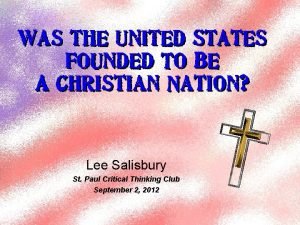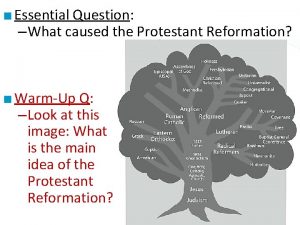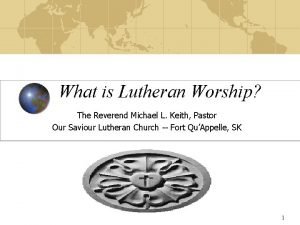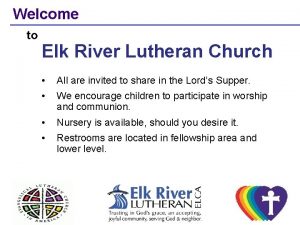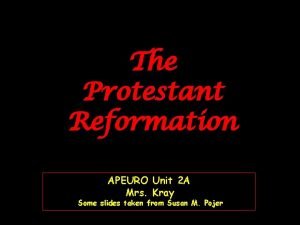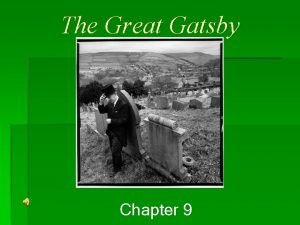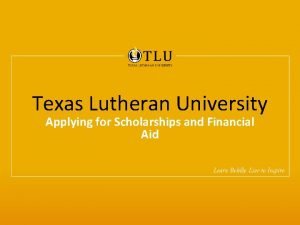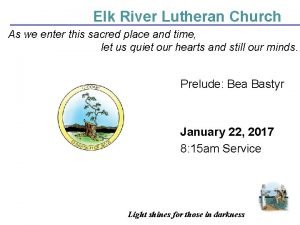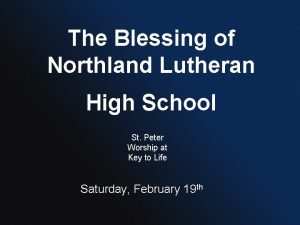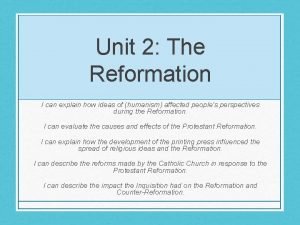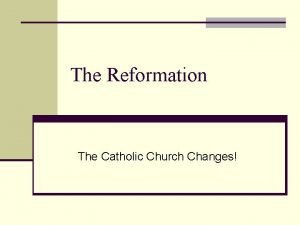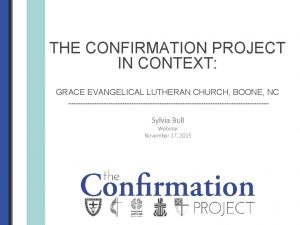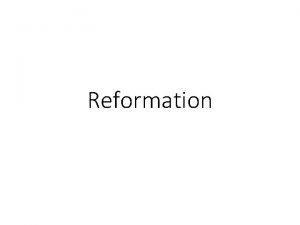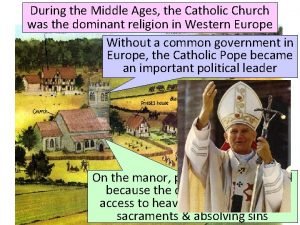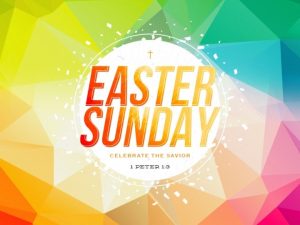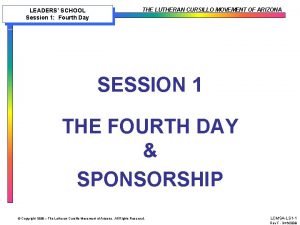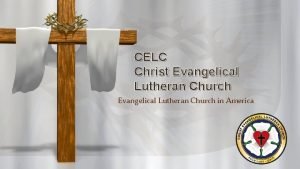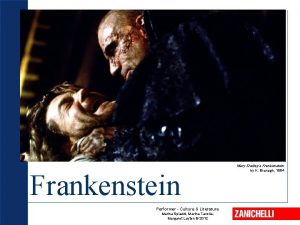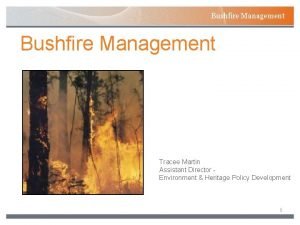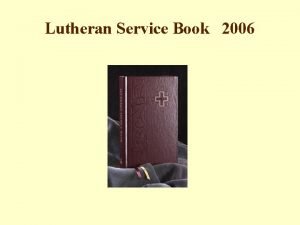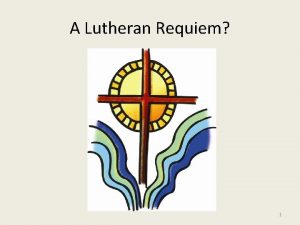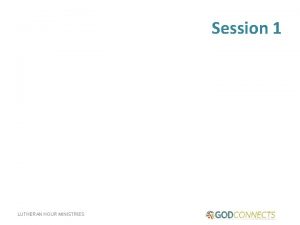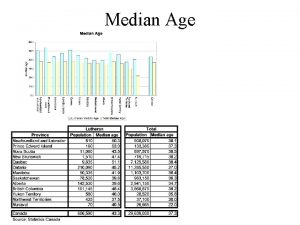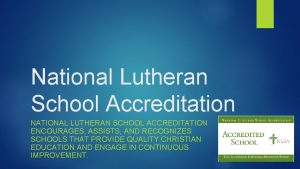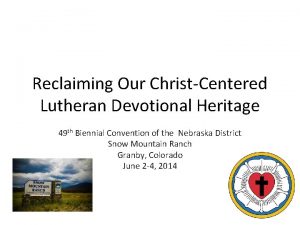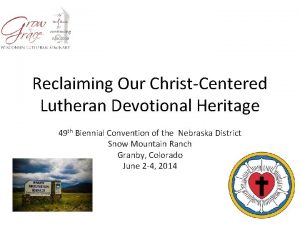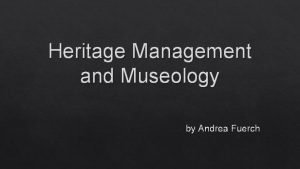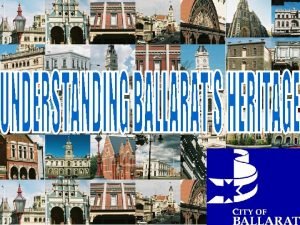Lutheran and Episcopalian Heritage Part 1 Lutheran and









































- Slides: 41

Lutheran and Episcopalian Heritage: Part 1

Lutheran and Episcopalian Heritage • Feb. 10: Lutheran History-- Martin Luther's theology, the reformation, and the early Lutheran Church (Ashley Hall) • Feb. 17: The Evangelical Lutheran Church in America today -- theology, practices/beliefs (Ashley Hall) • Feb. 24: Episcopal History -- Roots in Anglican tradition, relevant monarchs and the via media, Episcopal branch (USA) and the Book of Common Prayer (Tim Anderson) • March 3: The Episcopal Church Today -- Current beliefs and practices (Tim Anderson) • March 10: The Call to Common Mission -- Creation of the agreement ("communion") between the churches: What does it say? What does it mean? (Ashley Hall) • March 17: Dialogue on the relationship between the churches: What can/should we be doing now? (community discussion)

February 10: Lutheran History • Context – Crisis of Authority in the Church/Reform before the Reform – Church/State relations • Luther’s Theological Convictions – – – “Back to the future” Repentance and renewal Promise – Gospel – Righteousness Scripture and Tradition Sacraments and Liturgy Common Priesthood/Kingship • The Wittenberg Movement • Confessional Writings – Augsburg Confession and the Book of Concord • Misconceptions

Crisis of Authority in the Church • Avignon Papacy (1309 -1377) – a. k. a. “The Babylonian Captivity of the Church” – A crisis of three popes at the end • Counciliarism – The Council of Constance (1414 -1418) – The Council of Basel (1431) – Asserted that the Pope was first among equals and full authority was in the college of bishops • Pope as Prince

Crisis of Authority in the Church

Reforms before the Reformation • Counciliarism • Devotio Moderna and the Brethren of the Common Life – Thomas a’Kempis, The Imitation of Christ • • • The Beguines and Beghards Jan Huss John Wycliffe; John Colet Nicholas of Cusa and John Gerson Erasmus, Rudolf Agricola, and Johannes Reuchlin

The University and Scholarship • “Christian Humanism” was a return to an interest in the classical (i. e. , Greek and Roman) world and the early Church (i. e. , the Church Fathers; Athanasius, Basil, Augustine, Jerome, etc. ) • Dissatisfaction with the Scholastic consensus approach; saw the attempt to harmonize all authorities and its highly specialized language as dull and artificial. • The Scholastic system could not account for the newly discovered (and presumed lost) works of Aristotle, Plato, and the Church Fathers. • The Councils of Basel (1431) and Florence (1445) also brought interest in Greek Orthodox tradition. • Wanted to return ad fontes (to the sources) • A concern for the historical context of the author • Wanted a return to bonae litterae (good literature and eloquent writing)

Church and State: Europe ca 1500

Holy Roman Empire (1648)

Holy Roman Empire • A conglomeration of loosely affiliated principalities of varies sizes and significance ruled by secular and ecclesiastical lords. • Founded by Charlemagne in 800 • Ruled by an Emperor who was chosen by seven “Electors” • Electors: three spiritual (the Archbishops of Mainz, the Trier, and Cologne) and four secular: (the King of Bohemia, the Count Palatine of the Rhine, the Duke of Saxony, and the Margrave of Brandenburg).

Holy Roman Emperor HRE Maximilian I (r. 1493 -1519) HRE Charles V (r. 1519 -1556)

HRE Charles V

Elector Frederick “the Wise” Originally, the Duke of Saxony was also the Elector of the HRE. Frederick’s father died without choosing which of his sons would take the title. Frederick and his brother split the territory; his younger brother took the title Duke and smaller territory; Frederick took the title Elector and the larger territory. Saxony was rich in minerals (copper, tin, gemstones). Frederick used this wealth to elevate Electoral Saxony as a model of Renaissance Germany. To that end, he founded Wittenberg University in 1509.

Church and State Relations • The Church was at the foundation of society, politics, and commerce of Western Europe. • A symbiotic relationship: One Church, One Nation (Christendom; corpus Christianum)

Church and State Relations • While symbiotic, quite difficult • Each one claiming the need for freedom from the other to rule their affairs. – The Church: “freedom” from proprietary churches/benefices; bishop/Pope conferred the crown to king/Emperor but then had to kneel before him and swear loyalty. – The State: “freedom” from ecclesiastical taxation and interference (i. e. , moral guidance? ); did not like exemptions enjoyed by monks/friars and clergy. – Remember: both king/Emperor and bishop/Pope anointed as “God’s vicar” and swore to uphold a godly reign. What to do when they clashed?

Why Was Luther “Successful”?

Part 2: Luther and his Reforms • Luther’s (Brief) Biography • Luther’s Theological Convictions – – – “Back to the future” Repentance and renewal Promise – Gospel – Righteousness Scripture and Tradition Sacraments and Liturgy Common Priesthood/Kingship

Martin Luther (1483 -1546) (or, Luder, Ludder, Lutter!)

Martin Luther Born in Eisleben, 10 November 1483 Baptized on St. Martin’s Day Eldest son of Hans and Margarete Part of the growing middle class Elementary education at a school run by Brethren of the Common Life • 1501, entered the University of Erfurt • • •

Martin Luther • 1505, expected to continue his studies with Law School but entered the Augustinian Friars of the Strict Observance (i. e. , the Black Friars) – Friar vs. Monk – “…of the Strict Observance”

Martin Luther • Noted for his intellect, was sent by his superiors to continue his education. • Daily life of prayer and study of the Bible – NB: reject polemic that the Bible was “forbidden” • General Superior of the Order, Johann von Staupitz took him under his wing • 1507: ordained to the priesthood • 1509: sent from Erfurt to Wittenberg University 1512: Doctorate of Theology and accepted to the faculty at Wittenberg.

Martin Luther • Scrupulous, but not necessarily more so than any other devout person/friar of the age. • Particularly wrestled with the question “How do I find a gracious God? ” – It seems God holds us to a standard we can never meet; then judges us for not doing so – The medieval solution to “do one’s best” was not an adequate comfort: how much is enough? • His mentor and confessor, Staupitz, helped Luther to his breakthrough, which was to believe in the goodness of God and to trust in the promises made by God.

Core Theological Conviction • In a Letter (1518) to his mentor and superior, Staupitz, Luther explains the source of his theological breakthrough: – Through a study of Scripture in their original language, he was led to see that “the life of repentance” was not about satisfactions for sins but about a change of heart (metanoia) – This change of heart moved the sinner from dependence upon the self to dependence on the mercy and grace of God – Thus, the “righteousness of God” (Rom 1: 17) was not primarily in God’s justice/judgment but was in the fact that God a) loves creation and has redeemed it through Christ and b) will be faithful to his promise through Christ; thus, c) salvation is by grace alone and all good works are based on a faith (i. e. , trust) in that promise of grace. – Shift in focus: from “If I do X, then God must do Y” to “because God has done X, I may do Y/receive the blessings of doing Y”

Core Theological Conviction • From 1515 -1517, Luther has been studying, lecturing, and writing from his new understanding and generated no fuss. • But, in 1517, Johannes Tetzel OP, began selling indulgences through an exclusive license from the Elector-Archbishop of Mainz. • In an invitation to an academic debate (95 Theses) Luther challenged: – The selling of Indulgences – The application of Indulgences to the souls in Purgatory – NB: he does not challenge indulgences or purgatory and his arguments are made from: a) his new insight into “repentance” as well as b) the fact that Tetzel’s claims were in clear violation of canon law and previous papal decrees.

Core Theological Conviction • Sent a copy to his ecclesiastical lord, Albrecht, the Archbishop of Mainz, urging him to do something about this gross violation of canon law. • Luther did not know that Albrecht and Pope Leo X had made a deal to split the proceeds. • When Luther discovers this, he seems to have had a real crisis of authority himself.

Core Theological Conviction • First, authorities tried to ignore the situation. • Then, they tried to silence both figures (Luther and Tetzel). • Luther insisted (as a professor and priest) that his arguments should be given a hearing. • Bribery and threats failed and – in absence of a true hearing – Luther remained unmoved. • Meanwhile, events tapped into social unrest at the corruption of the Church.

Core Theological Conviction • At the Diet of Worms (1521), Luther condemned. • Convinced death was near, he writes feverishly. • His Elector protects him, he is allowed to return to the University and continues lecturing and writing. • He is the primary consultant for reforms but condemns (often harshly) “radicalism; ” esp. in the liturgy and social reform (i. e. , the Peasants Revolt). • Eventually marries and raises a large family. • Dies in 1546 at the age of 63.

Back to the Future • Luther understood himself to be doing nothing new but restoring an earlier, purer understanding of God’s Word. • His works draw heavily from St. Paul’s letters, but also Augustine and the patristic commentaries. • Though at times critical of Christian Humanism, he is heavily indebted to their research methods and has a far greater appreciation of Philosophy and Ethics than many of his subsequent followers.

Christ – Gospel – Promise • Early insight into repentance and renewal: we are first and foremost the recipients of God’s love and grace as revealed in Christ. – “Alien righteousness” • Thus, we must trust that promise (i. e. , take for granted/take as already given) if we are to be renewed daily as disciples. – Disciples should adopt a Theology of the Cross (self-giving love) not a Theology of Glory

Justification by Grace through Faith Alone • Justification (i. e. , being in a right relationship with God) depends on God’s action – not ours – to which we respond with trust. • Luther wants to bring into sharp relief the distinction (but not separation) between God’s work and ours. – Justification (God’s work) and Satisfaction (our response) • Luther: “We say that justification is effective without works, not that faith is without works. For that faith which lacks fruit is not an efficacious but a feigned faith. ” (LW 34) • Luther: “Faith is a living, restless thing. It cannot be inoperative. We are not saved by works; but if there be no works, there must be something amiss with faith” (Disputation on the Epistle of James)

Justification by Grace through Faith Alone

Sacraments • Because faith clings to the promise, we need to hear the promise repeatedly. • For the promise to be real, trustworthy, Christ must necessarily give of himself fully in the sacraments. • Thus, Luther adamantly refuses to deny the real presence of Christ “in, with, and under” the sacraments. • Reduces the medieval number of sacraments to those which clearly have the promise of Christ attached – First, he listed three; then considered Confession a subset of reclaiming the promises at Baptism.

Liturgy • Luther is notoriously conservative in his liturgical reforms. • He forbids iconoclasm. • He did not remove Latin from the liturgy; rather, the Words of Institution were translated and hymns added. • People received both bread and wine. • He removed the medieval preface to the Eucharist, which implied that the priest was co-offering the sacrifice. • Used the liturgies of St. Basil and Chrysostom as his guide.

Liturgy • Luther was also fairly ambivalent as to what other congregations did for liturgical reform. • Some Lutheran territories in the northwest and southwest (with large influence from the Reformed/Calvinist tradition) have very simplified liturgies. • Other Lutheran territories (esp. in the East and North) retained all vestments, baptismal exorcisms, incense, and processions (things abhorrent to the Reformed/Calvinist tradition). – These were not changed until the challenges of Rationalism and Pietism in the 18 th and 19 th century.

Liturgy

Liturgy

Common Misconceptions • Each generation seems to find inspiration from Luther; but in looking back the Luther they find tends to look more like them than the historical figure. • Luther was far more liturgical, sacramental, and affirming of the unity of philosophy and the natural sciences than many of us today.

Common Misconceptions • Sola Scriptura (Scripture alone) – – Commonly affirmed as the rally cry of the Reformation. Problem is: Luther never said it It is not even a good descriptor, if a complete rejection of tradition is implied. For Luther, the Gospel/Christ rules over Scripture and Tradition. • Priesthood of All Believers – First mentioned in the Freedom of a Christian, often taken to mean a rejection of clerical ordination and sacramental grace (i. e. , I am my own priest; I can stand before God). – Exact opposite of Luther’s point: he meant that we cannot say to the poor or needy “Go see the priest” but that we must be “intercessors” for one another; active responsibility within Community. – Speaking metaphorically (as when he speaks of a common kingship) and does not assume that everyone has the right to be an ordained pastor. – It is an appeal to responsibility and shared sacrifice, not a privilege or a rejection of a duly educated and called clergy.

Not a Lone Wolf

The Lutheran Confessions • The Augsburg Confession (1530) • A summary of Lutheran teachings, divided into two parts: common agreements with the Roman Catholic Church (e. g. , the Creeds, baptismal regeneration, bishops, and real presence) and points of division with the Roman Catholic Church (e. g. clerical celibacy, nature of good works, political power of bishops). • The central document uniting all Lutheran bodies.

The Lutheran Confessions • The Book of Concord (1580) • A subsequent summary of Lutheran teaching with addresses some of the doctrinal issues which came after the first generation of Reformers. • Particularly addresses challenges from the Reformed/Calvinist (e. g. , concerning the Eucharist and Free Will) and the Council of Trent.
 Critical thinking club
Critical thinking club Episcopalian beliefs
Episcopalian beliefs Classification of property under hindu law
Classification of property under hindu law Obstructed heritage in hindu law
Obstructed heritage in hindu law World heritage is our heritage slogan
World heritage is our heritage slogan What is lutheran
What is lutheran Elk river lutheran
Elk river lutheran Simony ap euro
Simony ap euro How does wolfsheim remember gatsby
How does wolfsheim remember gatsby Texas lutheran university scholarships
Texas lutheran university scholarships Lutheran church leadership structure
Lutheran church leadership structure Elk river lutheran church
Elk river lutheran church Yuen long lutheran secondary school
Yuen long lutheran secondary school Muhlenberg lutheran church
Muhlenberg lutheran church Northland lutheran high school
Northland lutheran high school Episcopal vs lutheran
Episcopal vs lutheran Bethany lutheran primary school
Bethany lutheran primary school Se_xs
Se_xs Catholic church organizational chart
Catholic church organizational chart Grace lutheran church boone nc
Grace lutheran church boone nc Lutheran vs catholic beliefs chart
Lutheran vs catholic beliefs chart Lutheran vs catholic
Lutheran vs catholic Christ lutheran preschool avon lake
Christ lutheran preschool avon lake Lutheran foundation of st louis
Lutheran foundation of st louis Trinity lutheran school joppa tuition
Trinity lutheran school joppa tuition Lutheran cursillo
Lutheran cursillo Eden care regina lutheran home
Eden care regina lutheran home Celc lutheran
Celc lutheran Christ evangelical lutheran church
Christ evangelical lutheran church Celc lutheran
Celc lutheran Christ evangelical lutheran church
Christ evangelical lutheran church Celc lutheran
Celc lutheran Evangelical lutheran church of hong kong
Evangelical lutheran church of hong kong Intangible cultural heritage and sustainable development
Intangible cultural heritage and sustainable development Performer heritage frankenstein
Performer heritage frankenstein Department of communities culture and heritage
Department of communities culture and heritage Barton hundley
Barton hundley Relieve de la india
Relieve de la india The tangible and intangible heritage in my local area
The tangible and intangible heritage in my local area Defence environment and heritage manual
Defence environment and heritage manual Part whole model subtraction
Part whole model subtraction Part to part ratio definition
Part to part ratio definition
